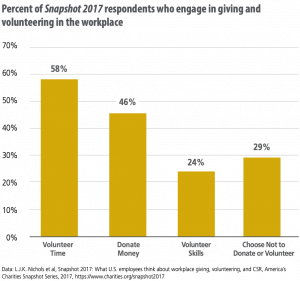A new Giving USA Special Report, The Evolution of Workplace Giving, shows that corporate giving reached $20.77 billion dollars in 2017—its highest level ever. Workplace giving has evolved so that corporate employees have more autonomy and options to support nonprofits. Their research provides important guidance for fundraising professionals. We have distilled three key insights from the report and offer advice to bolster your development efforts with corporate partners and their employee base.
1. Make corporate employee partnerships a documented part of your workplace giving development strategy
Corporate philanthropy is on the rise, increasing by 8% from 2016 to 2017. According to the special report, giving by corporations includes:
- Cash
- Corporate foundation grants
- In-kind contributions made through corporate giving programs
- Matching gifts
- Employee giving campaigns
In addition, companies are increasingly embracing corporate social responsibility (CSR) as part of their business strategy. The report cites “clear evidence for a positive correlation between a company’s social activities and financial return.”
Corporate philanthropy comprised only 5% of total giving in 2017. But, robust growth and the potential for productive partnerships make corporate giving a worthy pursuit.
What you can do:
Make corporate employee giving an integral part of your philanthropic portfolio: document your purpose and desired outcomes in your organizational strategy, and gain buy-in from the top down. Engage your board in identifying and cultivating corporate prospects.
2. Organize your outreach to corporate employees
In the past, “workers who donated to campaigns tended to have limited direct contact with the nonprofit organizations receiving funds, and the decisions about the recipients were decided largely by management, rather than employees.” These practices have changed considerably.
Today’s diverse, multi-generational employees demand options with the organizations and causes they support through the workplace.
Employers are listening—and nonprofits are benefitting.
Among respondents who engage in workplace giving, 46% donate money to their preferred causes. (And 58% volunteer their time.)
Of the $20.77 billion given by corporations in 2017, $4 billion came from employees through workplace giving campaigns.
But even in the face of this heightened generosity, gaps exist. Research revealed that “the median percentage of employees participating in year-round matching gift programs was 9% in 2016.” Further, “an estimated $6 to $10 billion in matching gift funds is unclaimed each year.” These gaps present huge opportunities for nonprofits to creatively engage corporate employees.
What you can do:
Keep track of the corporate employers of all of your donors and volunteers. Identify corporations in your locale that: (a) have active Employee Resource Groups (ERGs), and (b) offer employee gift-matching programs. Cultivate partnerships and offer meaningful opportunities for corporate employees to engage with your organization.
3. Build opportunities for triple-win scenarios
The evidence is clear. Corporate giving campaigns have win-win-win consequences.
- Corporations win.
- “CSR helps to make a corporation more competitive in hiring highly qualified applicants.”
- “A national survey…found that consumers tend to have more positive attitudes toward companies that engage in CSR.”
- “Over 50% of survey respondents indicated that they were likely to buy stock in a company with high ethical standards and more likely to purchase from a company with sustained year-round CSR programs.”
- Employees win.
- “…When employees are involved in a company’s CSR initiatives, they frequently display positive commitment and a stronger emotional attachment to their companies.”
- “Millennials, Gen Xers and Baby Boomers are…highly invested in working for companies whose work aligns with their values and goals.”
- “Over 60% of respondents identified the ability to choose [which cause to receive their donated time and money] as valuable or extremely valuable in their decision to give.”
- Your nonprofit wins.
- “…Strategic benefits for nonprofits who engage with corporate volunteer programs include raised awareness of social issues among volunteers and corporate sponsors, capacity to take on projects that they would not have been able to manage without corporate help, and new partnerships that serve as a point of entry for additional future donations.”
What you can do
As for how to improve your partnerships with corporations and their employees, the authors of the special report offer these tips.
- “Clearly communicate with partners as to what both organizations hope to gain.”
- “Start small and select only a few participants for a pilot program.”
- “Ensure that the program is regularly monitored.”
- “Make efforts to check-in with participants.”
4. In Summary
The Giving USA Special Report: The Evolution of Workplace Giving is replete with insights to help your nonprofit organization. You can strengthen your corporate development efforts when you (1) make corporate partnerships a documented part of your development strategy; (2) organize your outreach to corporate employees; and (3) build opportunities for triple-win scenarios. The data is on your side. Now is the time to invite your local corporations and their employees to join your team, too.






